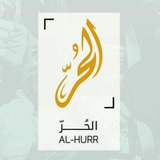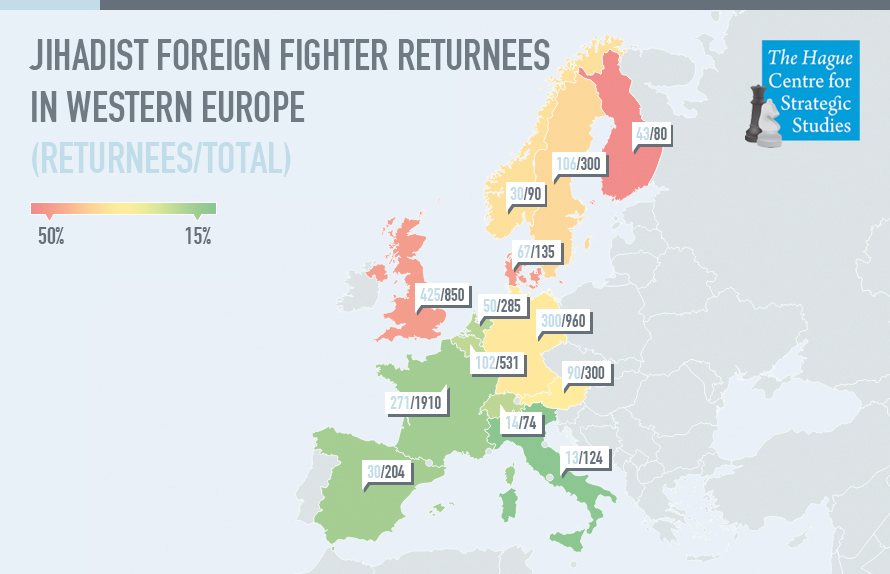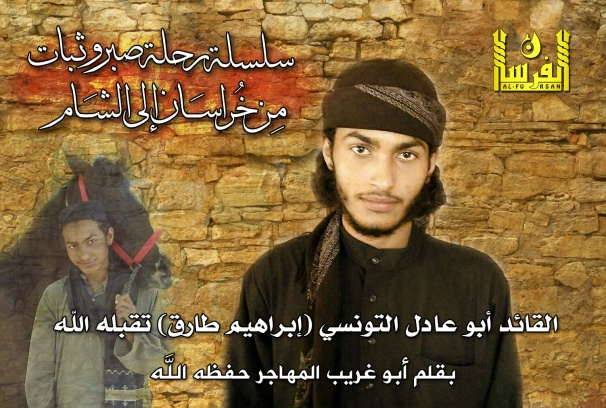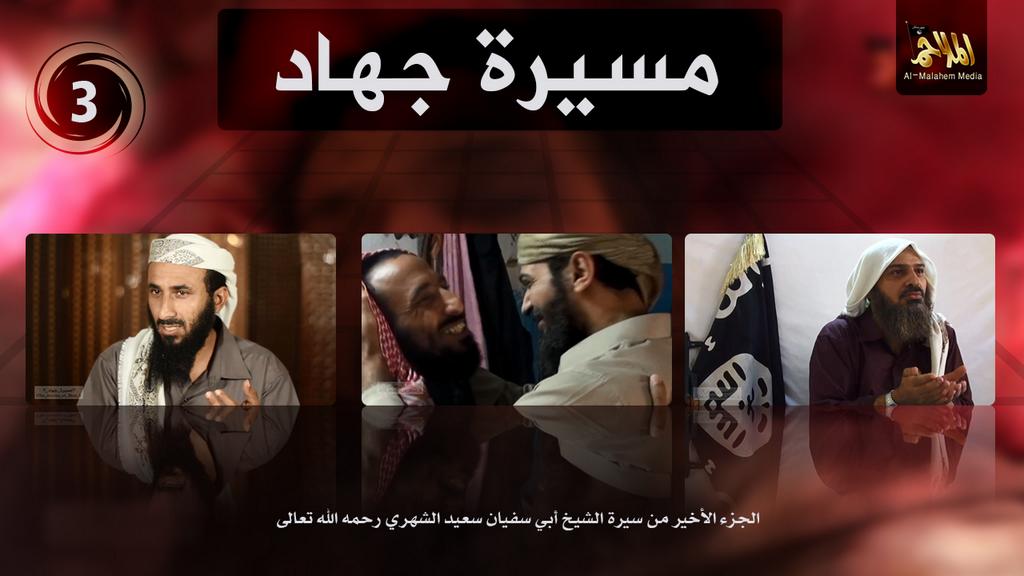Search Results for: journey of jihad
al-Malāḥim Media presents a new video message from al-Qā’idah in the Arabian Peninsula: “Journey of Jihād #2: The Biography of Sa’īd al-Shihrī"
NOTE: Click here for the first part in this video series.
—

__________
To inquire about a translation for this video message for a fee email: [email protected]
al-Malāḥim Media presents a new video message from al-Qā’idah in the Arabian Peninsula: "Journey of Jihād #1: The Biography of Sa'īd al-Shihrī"

___________
To inquire about a translation for this video message for a fee email: [email protected]
New video message from Anṣār Ghazwat al-Hind: “My Journey to Free Jihād: Message of the Emigrant Abū Ḥamās”

___________
Source: Telegram
To inquire about a translation for this video message for a fee email: [email protected]
New release from Shaykh Muḥammad Bin Yāsir Bin Maṣ’ūd (Abū ‘Ammār al-Ḥaḍramī): “Journey To the Hereafter”

Click the following link for a safe PDF copy: Shaykh Muḥammad Bin Yāsir Bin Maṣ’ūd (Abū ‘Ammār al-Ḥaḍramī) — Journey To the Hereafter
_______________
Source: RocketChat
To inquire about a translation for this release for a fee email: [email protected]
Eye On Jihadis in Libya Weekly Update: April 9
On 9 April, IS claimed responsibility for an attack on the town of Fuqaha, in the southern Jufra region. Arriving in as many as 15 vehicles, IS cut off communications to the town, burnt down several houses and executed the head of the municipal guard. Three civilians who had been released from captivity in Ghaduwwa were killed in the incident. In their claim of responsibility, IS said the attack was a part of the “battle of revenge for al-Sham.”
On 1 April, the Misrata Security Directorate reported that its Bomb Disposal Unit had disposed of four tonnes of unexploded ordinances (UXOs) planted by IS in east Sirte in 2016. On 28 March, the Mayor of Sirte, Mukhtar al-Madani, met with representatives of the Danish De-mining Group (DDG) to establish teams to inspect former conflict zones associated with the 2016 IS conflict in order to detected UXOs. On 28 March, a Libyan news media outlet published the testimony of a civilian kidnapped by IS fighters late last year and held captive in a ‘prison’ on a farm in the Ghaduwwa area before being rescued by security forces. The individual recounts being taken in vehicles through the Harouj area and stopping throughout the journey to bury mines. The captive identified the leader of the IS group that kidnapped them as being a ‘Yemeni emir’ who has vowed to launch more raids on Fuqaha. On 25 March, the Sabratha Security Directorate reported it had arrested a suspected IS member. The individual is to be prosecuted but no other information is available at this time. On 9 April, unconfirmed reports suggest Abrek Maazak, also known as “Abrek the Egyptian,” has been released from prison and is participating in the clashes in Tripoli. Maazak is a founding member of Ajdabiya Revolutionaries Shura Council, an Islamist brigade formerly linked with Ansar Al-Sharia and the Benghazi Revolutionaries Shura Council. Maazak had been arrested, along with Saadi Abdullah Abukzim al-Noufali, in October 2017 by Misrata security forces. On 29 March, two al-Qaeda members from Derna were reported to have been arrested in Misrata. The individuals are said to have participated in fighting in Syria with Katibat al-Batar.A weekly update of IS’s actions, the Western response, and developments pertaining to Libya’s other militias is available by subscribing here. To read about Western countries’ responses to IS in Libya this week, click here, and to read about the developments within the anti-IS Coalition of Libyan militias, click here. To read all four sections of this week’s Eye on IS in Libya report, click here.
GUEST POST: Coming Home: Explaining the Variance in Jihadi Foreign Fighter Returnees Across Western Europe
As with all guest posts, the opinions expressed below are those of the guest author and they do not necessarily represent the views of this websites administrator and does not at all represent his employer at the Washington Institute for Near East Policy.
Jihadology.net aims to not only provide primary sources for researchers and occasional analysis of them, but also to allow other young and upcoming students as well as established academics or policy researchers to contribute original analysis on issues related to jihadism. If you would like to contribute a piece, please email your idea/post to azelin [at] jihadology [dot] net.
Click here to see an archive of all guest posts.
—
Coming Home: Explaining the Variance in Jihadi Foreign Fighter Returnees Across Western Europe
By Reinier Bergema and Colonel RNLAF (ret.) Peter Wijninga
Little is left of the Islamic State’s territorial control, which, at one point, stretched from Aleppo, Syria to Fallujah, Iraq. The intensification of the 60 nation coalition’s effort to defeat the Islamic State has borne fruit, regaining control over key urban strongholds, such as Raqqa and Mosul. Yet, with the degradation of Islamic State territorial control, European nations may face an influx of returnees. The international intelligence and security community has already indicated that, while the IS’s territorial control may cease to exist, it is highly likely that IS as an underground terrorist organization will continue its jihad against Middle-Eastern and Western targets. Not only do they fear that returning fighters have, while in the trenches, adopted the radical anti-Western ideologies of their jihadi peers, but also that they would return to European soil, heavily traumatized and familiar with a wide range of heavy weaponry and explosives. The fact that the 2014 shooting at the Jewish Museum in Brussels, the November 2015 Paris attacks, and the 2016 Brussels bombings involved returned operatives appears to confirm this.
With at least 6,800 European nationals fighting in Syria and Iraq1, and estimates suggesting that approximately a quarter – nearly 2,000 – have already returned, the risk is not insignificant. Monitoring these returnees has added significant strain to European intelligence and security services. Closer examination of the available data shows a variance in the number of returnees per country. A (rough) distinction can be made between Northern and Southern European countries (see figure). While countries such as Italy (10.5%, 13/124), France (14.2%, 271/1910), and Spain (14.7%, 30/204) are facing relatively low percentages of returnees, countries such as Denmark (49.6%, 67/135), the United Kingdom (50%; 425/850), and Finland (53.8%; 43/80) have a significantly higher share of jihadi foreign fighters returning. Where does this variance stem from?

FIGURE 1. JIHADI FOREIGN FIGHTER RETURNEES IN WESTERN EUROPE (RETURNEES/TOTAL)
First, there is a difference in terms of approach between the mostly Southern European countries on the one hand and the Northern European, especially Scandinavian, countries on the other, with the latter tending to focus much more on the reintegration and rehabilitation of returnees. This soft approach may lower the threshold for disillusioned jihadis that are hoping to return to their home country.2 In Sweden, authorities have experimented with housing, employment, education, and financial support, with the aim to reintegrate returnees back into society.3 The Danish so-called ‘Aarhus model’ aims at disengagement, offering returnees a second chance.4 On the other end of this continuum, the prospects of returning to normal life in countries taking a more repressive approach are significantly limited, given the probability of severe penalties upon their return. For example, France, with a significantly lower share of returnees, takes a much more repressive approach, as it is capable of stripping fighters from French nationality, revoking passports, and/or sentencing them to long jail terms.5 The Pontourny Center, France’s first, and only, deradicalization program closed its doors in August 2017.6 In Italy, administrative deportation of foreign suspects is a common measure: since early 2015, the authorities have deported more than two hundred individuals deemed a threat to national security.7
Second, apart from the perspectives upon their return, there is a distinction to be made in terms of national approaches in facilitating return journeys. Danish foreign fighters wishing to return to their home country are actively repatriated, a tactic that fits its inclusive approach.8 The Netherlands requires its nationals to report to a Dutch embassy or consulate, before they acquire the right to be repatriated.9 This requirement makes it inherently difficult to return, given the limited possibilities of free and safe travel in Syria and Iraq. Additionally, passports and travelling documents were oftentimes confiscated by IS upon arrival in the Caliphate, or sometimes deliberately burned by the fighters themselves, making travel even more difficult. Other countries simply refuse to repatriate its citizens, as they suggest jihadis should be tried or even killed abroad.10
Third, in an attempt to prevent fighters from returning, several countries, including France and the United Kingdom, but also the United States, have formulated a hit list, deliberately targeting their own nationals, aiming to eliminate them and thereby prevent them from returning. Although such extrajudicial killings are obviously far from undisputed, they prefer a dead jihadi over a captured one – a notion that is shared by countries without such a list.11 Although not all countries have formulated such a hit list, it is possible that these countries provide crucial intelligence that may lead to the targeted assassination of its own nationals. The Netherlands, for example, could provide intelligence to its coalition partners, that may contribute, directly or indirectly, to the targeting process.12
Fourth, although there is limited data available on the European level, and the lion share of returnees were part of IS (in Belgium: 64/353; 18.1%), data on the Belgian sample shows that the relative share of returnees who were members of the Al Qaeda-affiliated Jabhat al-Nusra (14/55; 25.5%) seems to be bigger.13 Although there is no similar data available for the Netherlands, approximately twenty jihadis returned before IS became a player in Syria, potentially implying a similar process at work.14 This seems to be in line with the general belief that IS tends to be significantly more repressive when it comes to fighters attempting to leave their ranks.15 (Suspected) defectors are generally considered as spies or traitors, resulting in execution.16 Hence, a possible explanation for the different numbers of returnees may lie in the different policies of the organization the jihadis have joined. This hypothesis requires further exploration.
So far, a higher share of returnees has not necessarily translated into more terrorist attacks. The 2014 shooting at the Jewish Museum in Brussels, the November 2015 Paris attacks, as well as the 2016 Brussels bombings were conducted by returnees of French and/or Belgian origin. Moreover, the perpetrators of these attacks returned to Europe under the radar of the European intelligence and security community. It is unclear how many jihadis – with or without malicious intent – have returned to Europe beyond the gaze of intelligence and security services. So far, the number of returnees that was involved in terrorist attacks in Europe has been limited. Yet, given their vast number, they represent a significant security challenge for their home countries. Even with the so-called Islamic State collapsed, the conflict in Syria and Iraq has provided a new impetus to global jihadism for years to come.
Reinier Bergema is a Strategic Analyst at The Hague Centre for Strategic Studies and Colonel RNLAF (ret.) Peter Wijninga is a Subject Matter Expert in Defense & International Security at The Hague Centre for Strategic Studies
Notes
__________
1 See: https://dwh.hcss.nl/apps/ftf_monitor/#section-ftf-total 2 Charles Lister. Returning Foreign Fighters: Criminalization or Reintegration? (Doha: Brookings Institution, August 2015). Retrieved from https://www.brookings.edu/wp-content/uploads/2016/06/En-Fighters-Web.pdf 3 Lizzie Dearden, “Swedish city to offer returning Isis fighters housing and benefits in reintegration programme”. Independent (October 20, 2016). Retrieved from https://www.independent.co.uk/news/world/europe/sweden-isis-fighters-city-lund-returning-jihadis-housing-job-education-benefits-reintegration-a7371266.html 4 Alastair Reed & Johanna Pohl. Tackling the Surge of Returning Foreign Fighters (The Hague: International Centre for Counter-Terrorism (ICCT), July 2017). Retrieved from https://icct.nl/publication/tackling-the-surge-of-returning-foreign-fighters/Eye On Jihadis In Libya Weekly Update – October 4, 2017
IS in Action
On 28 September, the head of Investigations at the Attorney General’s (AG) Office, Sadeq al-Sour, held a press conference in Tripoli in which he gave the names and affiliations of several IS and Ansar al-Sharia connected individuals in Libya. He also provided details and photographs of accused, organizational charts, links and routes of travel into Libya based on 14 months of investigation. While many of the revelations and individuals named were already in public domain, this was the first time they were officially revealed or confirmed by official judicial Libyan authorities.
Al-Sour revealed that about 800 arrest warrants had been issued for nearly 200 terrorist attacks in Libya. He said there are currently 250 cases before the courts and that more than 1,000 elements belonging to terrorist organizations are wanted for justice. He also said that a database has been created containing all the information on 1,500 ISIS members.
Foreign links
Al-Sour said that more than 1,000 people belonging to terrorist organizations are wanted for justice, a large number of whom are wanted in Turkey, Syria, and Iraq. Fifty warrants will be delivered to Interpol for ISIS suspects abroad. He added that more than 700 bodies of ISIS fighters from Sirte are being held in mortuary fridges.
Regarding leadership of IS in Libya, he claimed several Arab leaders rotated the command of IS in Libya, in coordination with the Libyan IS leadership. He said there are Libyan individuals who participated in the Syrian war and returned to Libya with an IS philosophy, however he also said that most IS members had not been Libyan, but that they had come from Sudan, Egypt, Tunisia, Mali, and Chad. There are still a lot of individuals in the Sudan and Tunisia who are recruiting members.
Suspects – believed dead
Many of the perpetrators of terror attacks in Libya that al-Sour mentioned are believed dead, with many killed in the battle or Sirte. These include:
- Abu Amer al-Jazrawi, a Saudi commander of IS in Sirte
- Abdulhadi Zaroon, one of the important IS leaders in Sirte
- Wissam Najm Abd Zayd al-Zubaydi, an Iraqi commander also known as Abu Nabil al-Anbari, who was appointed commander of IS in Libya.
- Hasan Araj, who according to al-Sour was the first person to be recruited by IS in Libya
Suspects – wanted
- Mahmoud al-Barasi, the commander of IS in Benghazi. He is wanted for arrest and according to al-Sour, is currently located in the south of Bani Walid.
- Mahdi Salem Rajab Dingo, who was responsible for IS’s staff and military office
Attacks
Al-Sour said that more than 200 suicide bombers and assassinations had been identified across Libya. Al-Sour listed several attacks and assassinations for which he said IS was responsible. These included:
- The Egyptian Copts who were killed in Sirte. He said that the burial sites had been identified behind Sirte’s Mahari hotel and that the AG’s Office had all the information about those responsible for the slaughter.
- The kidnapping of the Italians in Sabratha
- The murders of former Attorney General Abdulaziz al-Hassadi, HoR member Freha al-Barkawi, Hasan Dakam, Sheikh Mohammed bin Othman and the director of the security of Sabratha, Hasan Kamuka.
- Attacks on oil fields and the kidnapping of foreigners
- Many murders, kidnappings, and assassinations in Sabratha
IS funding
Al-Sour said that IS kidnapped businessmen and used the ransoms for funding. He added that most of IS’s funding came via high ranking commanders in Syria and Iraq as well as through gaining control of various Libyan banks including Central Bank of Libya branches in Sirte, Benghazi, and Derna. He revealed that the AG’s Office had issued summons for some Libyan officials who had supported some terrorist figures financially.
IS cells
Al-Sour claimed that Derna, which is currently under the control of the Derna Mujahadeen Shura Council (DMSC) was preparing itself to become an emirate like Syria and Iraq. He also said there were numerous IS cells operating across Libya, including in Misrata. He said that the AG’s Office had information about cells trying to activate themselves in Libya, one of which is connected to the Hamas movement.
Other Jihadi Actors
On 28 September, the head of Investigations at the Attorney General’s (AG) Office, Sadeq al-Sour, held a press conference in Tripoli in which he gave the names and affiliations of several IS and Ansar al-Sharia connected individuals in Libya. He gave official confirmation that Ansar al-Sharia were the nucleus of the formation of IS in Libya and that the majority of Libyan IS leaders were former al-Qaida members. He also said the financing of Ansar al-Sharia emanated from the Libyan state.
Al-Sour claimed that the storming of the US Special Mission in Benghazi on 11 September 2012, and the subsequent death of US ambassador Chris Stevens and three others, was carried out by Ansar al-Sharia. He said Mohamed al-Zahawi, the leader of Ansar al-Sharia in Benghazi, was responsible for the operation. He added that Ansar al-Sharia and al-Qaida were taking instructions from al-Qaida leader Ayman al-Zawahiri directly. It is interesting that this revelation was made as the trial of a key suspect in the case gets underway in the US.
On 2 October, the U.S. District court for the District of Columbia began the trial of Ahmed Abu Khatallah, the Libyan man accused of orchestrating the Benghazi attack. Khatallah has been awaiting trial in the US since 2014, when he was captured by a team of US military and FBI officials in Benghazi and transported on a 13-day journey to the US aboard a Navy vessel. The case is expected to last several weeks.
On 1 October, Ahmed al-Mismari, the spokesperson for the Libyan Nationa Army (LNA), said that IS and branches of the Muslim Brotherhood affiliated to al-Qaida have joined forces to spread extremism in Libya. He claimed that Qatar is transporting armed IS fighters from Syria to Libya and that Qatar continues to provide financial support for terrorist organizations in Libya.
__________________
A weekly update of ISIS’s actions, the Western response, and developments pertaining to Libya’s other militias is available by subscribing here. To read about Western countries’ responses to ISIS in Libya this week, click here, and to read about the developments within the anti-ISIS Coalition of Libyan militias, click here. To read all four sections of this week’s Eye on ISIS in Libya report, click here.

New release from al-Fursān Media: “Journey of Patience and Persistence Series- From Khurāsān to al-Shām #2"
Click here for the first part in this martyrology series.
—

Click the following link for a safe PDF copy: al-Fursān Media — “Journey of Patience and Persistence Series- From Khurāsān to al-Shām #2
_____________
To inquire about a translation for this release for a fee email: [email protected]
New release from al-Fursān Media: "Journey of Patience and Persistence Series- From Khurāsān to al-Shām #1"

Click the following link for a safe PDF copy: al-Fursān Media — Journey of Patience and Persistence Series- From Khurāsān to al-Shām #1
______________
To inquire about a translation for this release for a fee email: [email protected]

